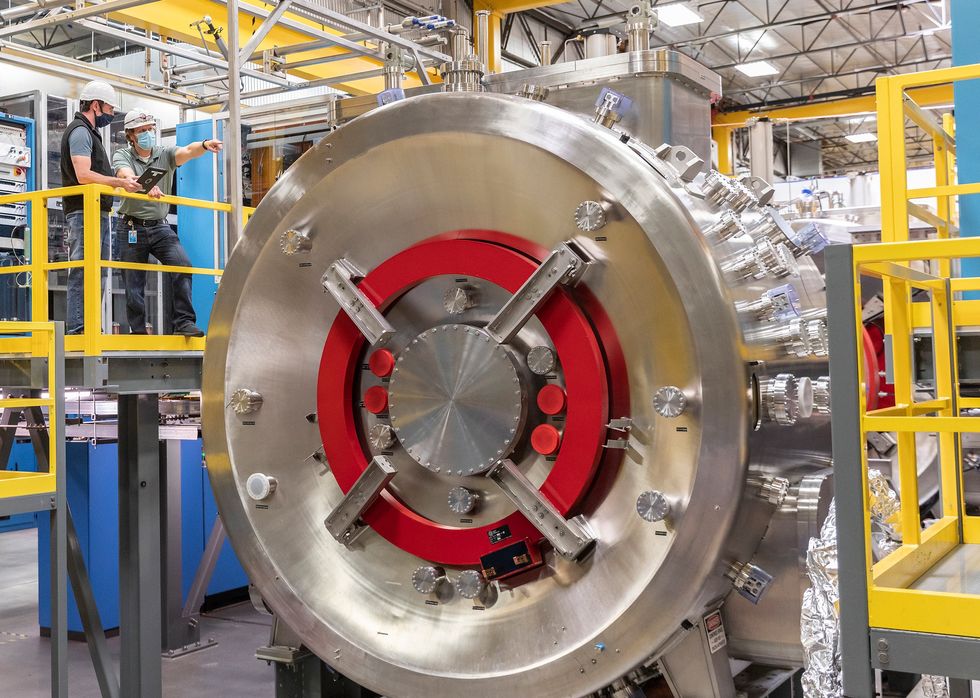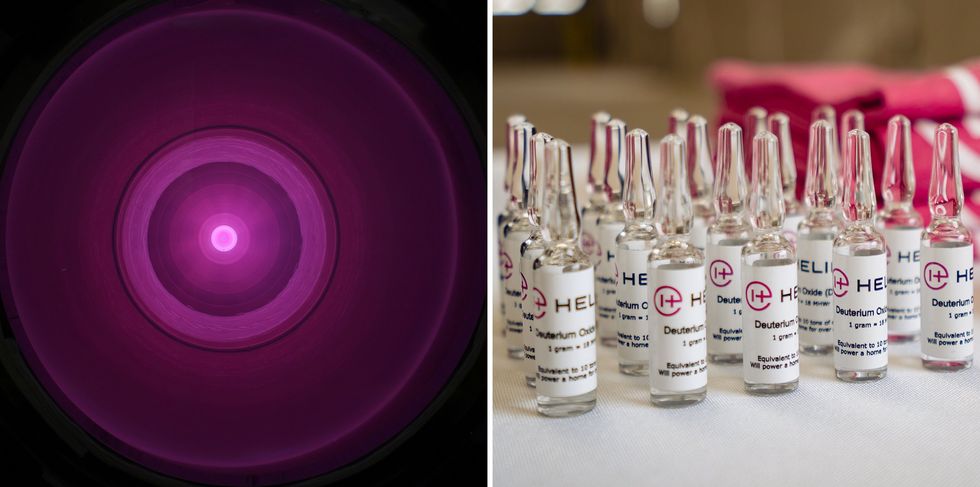

Interest in fusion energy is surging today in response to the world’s desperate need for abundant clean power. At least 43 private companies are now pursuing this goal of safely fusing two atomic nuclei to form a heavier nucleus while releasing energy. However, the standard deuterium-tritium (D-T) reaction at the core of conventional fusion reactors conceals big, long-term problems.
D and T are hydrogen isotopes that fuse at lower temperatures and release more energy than other reactions. But they also yield a superflux of neutrons, mandating complex (and still unperfected) containment technologies to keep the neutron radiation from wrecking reactor walls, supportive infrastructure, and nearby living things.
“In the last decade or so, people have started to think more and more about advanced fuels, because of how much damage neutrons can do.”
—Gerald Kulcinski, University of Wisconsin
A new breed of maverick fusioneers is aiming to solve the neutron problem. Their approach is to swap D-T fuels for readily available elements that, when fused, release energy that’s carried by charged particles, instead of neutrons. Proponents of this method, aneutronic fusion, argue that the devices will ultimately be easier to build and better suited to power systems, since it will be easier to convert the energy of charged particles into electricity. They also produce little or no radioactive waste.
“There was a lot of work in what we then called ‘advanced fuels’ from the 1960s through the 1980s,” says Gerald Kulcinski, a nuclear engineer and professor emeritus at the University of Wisconsin. The work fell out of favor, he says, “because it’s about 10 times harder to produce that reaction than it is the D-T reaction. But in the last decade or so, people have started to think more and more about advanced fuels, because of how much damage neutrons can do to [a reactor’s] first walls.”
Hydrogen-boron fusion
TAE Technologies, formerly known as TriAlpha Energy, has the most established private aneutronic fusion program. The company launched in 1998 and is now capitalized at about US $1.25 billion, according to CEO Michl Binderbauer. TAE’s approach calls for fueling its reactions with hydrogen and boron, a mix also known as p-B11. When fused, hydrogen-boron releases three positively charged helium-4 nuclei, known as alpha particles.
The TAE design confines plasma—fuel so hot that electrons are stripped away from the atoms, forming an ionized gas—via a technique called a field-reversed configuration (FRC). In an FRC, the plasma contains itself mostly in its own magnetic field, rather than relying on an externally applied field.
 TAE Technologies have been a mainstay in the field of developing the possibility of hydrogen-boron fusion (a.k.a. p-B11 fusion)—a fuel mix whose reactions are difficult to maintain but also whose byproducts lack the corrosive and high-radioactive presence of neutrons. TAE Technologies
TAE Technologies have been a mainstay in the field of developing the possibility of hydrogen-boron fusion (a.k.a. p-B11 fusion)—a fuel mix whose reactions are difficult to maintain but also whose byproducts lack the corrosive and high-radioactive presence of neutrons. TAE Technologies
TAE’s cylindrical linear research reactor, dubbed Norman, is capped on each end by inward-facing electromagnetic plasma cannons, which accelerate rings of plasma into a central chamber. There, the rings combine to create a single cylindrical plasma, stabilized by a beam of neutral atoms coming in from the sides. These beams also heat the plasma and supply it with fresh fuel. TAE’s power-plant design would deposit heat in the containment vessel’s walls and convert it to steam to drive a turbine using a conventional thermal-conversion system.
“It’s a superelegant beast,” says Binderbauer. “In typical magnetic-confinement designs, about 60 percent of the cost of the machine is the cost of the magnets. If you can make the most of your magnetic field with the plasma itself, it gives you a huge advantage economically.”
But FRCs have historically proved to be unruly: If the plasma misbehaves, the confining magnetic field also disintegrates and the plasma cools. Binderbauer’s team has spent the past decade researching means to stabilize the plasma. In recent years, the company has developed methods and hardware to reshape and reposition the plasma in real time, taking advantage of advances in artificial intelligence and machine learning.
“We now have that stability,” Binderbauer says. “We can manipulate these currents and keep them steady and stable. We get beautiful magnetic fields, behaving exactly the way they are predicted.”
There’s another significant downside to burning hydrogen-boron fuel to create fusion energy, Binderbauer says: It requires extreme temperatures, more than 3 billion degrees Celsius—20 or 30 times as high as the temperatures required for a deuterium-tritium reaction. The traditional thinking among many physicists is that, at these temperatures, the electrons will radiate so much that they’ll cool the plasma faster than it can be heated.
Binderbauer counters that mostly radiation by electrons will carry out the energy, but the temperature of those electrons is clamped by relativistic effects. “Since the 1990s we’ve done extremely sophisticated work and published a bunch of peer-reviewed papers. Others have measured these things and found that there is no catastrophic radiative cooling that kills the state.”
Betting on a rare isotope
Ten-year-old Helion Energy also plans to use a field-reversed configuration in the plant it is building in Everett, Wash. But instead of hydrogen-boron, the company is placing its bets on a helium-3 and deuterium fuel cycle.
Unfortunately, helium-3 is extremely rare—accounting for just 0.0001 percent of available helium on Earth—and thus extremely expensive to produce. Helium-3 could eventually be mined on the surface of the moon, where an estimated 1.1 million tonnes exist. But instead of building a spaceship, Helion plans to breed helium-3 in its reactor via deuterium-deuterium side reactions. Thus far, the company has produced only a very small amount of helium-3, but they intend to use “a patented high-efficiency closed-fuel cycle” to increase helium-3 output.
 Helion Energy aims to fuse two rare isotopes of very common elements—the extra lightweight helium isotope helium-3 with the heavy hydrogen called deuterium. On the left, its concentric purple-pink rings reveal a plasma at the core of Helion’s Trenta reactor. On the right, fuel vials of deuterium oxide. Helion Energy
Helion Energy aims to fuse two rare isotopes of very common elements—the extra lightweight helium isotope helium-3 with the heavy hydrogen called deuterium. On the left, its concentric purple-pink rings reveal a plasma at the core of Helion’s Trenta reactor. On the right, fuel vials of deuterium oxide. Helion Energy
“D-helium-3 could be the stopgap step between deuterium-tritium and p-B11,” says Kulcinski, “since the reaction requires a temperature of several hundred million degrees, in between deuterium-tritium and pB11.”
The D-helium-3 reactions aren’t completely aneutronic, but they release only about 5 percent of their energy in the form of fast neutrons. That won’t completely eliminate the complications of radiation damage, but it will reduce them significantly.
Helion’s reactor, like TAE’s, will be a cylinder capped with opposing plasma cannons. Rather than attempting to create a sustained reaction, the machine’s plasma guns would pulse about once a second, the company says, creating a stationary FRC in the center and condensing the plasma with a magnetic field until it becomes hot and dense enough to fuse. As the energy is released, the plasma will push outward against the magnetic field, allowing the system to harvest the charged energy through magnetic coils.
“These are innovations that are on the margins,” says Matthew J. Moynihan, a nuclear engineer and fusion consultant to investors. “Both ramping up the frequency of the pulsed approach and breeding helium-3 are going to be challenging to do on a scale that’s going to be needed for a viable power plant.”
To create the pulses, the Helion device will depend on large banks of capacitors that will store a whopping 50 megajoules of energy and discharge it in less than a millisecond—over and over again.
 Helion Energy’s reactor uses magnets to confine a hydrogen-helium plasma and compress the mixture to temperatures sufficient to spark nuclear fusion. Helion Energy
Helion Energy’s reactor uses magnets to confine a hydrogen-helium plasma and compress the mixture to temperatures sufficient to spark nuclear fusion. Helion Energy
Despite this technical hurdle and others, Helion lined up its first customer for a power plant that it says will go on line in 2028. The company recently finalized an agreement with Microsoft to provide at least 50 megawatts of electricity—enough for a factory or data center—after a one-year ramp-up period.
Many in the fusion-energy community dismissed it as a publicity stunt, or at best an overoptimistic reach for a company that has yet to demonstrate a net energy gain from its reactions. But these days, optimism is growing in an industry that is racing to solve the climate crisis—with or without neutrons.
Other promising approaches:
HB11
Australia-based HB11’s reactor concept uses high-powered lasers combined with magnetic confinement to fuse hydrogen and boron. The approach makes use of ultrashort pulses of chirped-pulse-amplification lasers—the subject of the 2018 Nobel Prize in Physics—to rapidly accelerate hydrogen through a boron fuel within a trapping magnetic field, creating a fusion event when they collide.
Marvel Fusion
Germany-based Marvel Fusion is pursuing laser-initiated inertial-confinement fusion using a high-energy laser and pB11 fuel in nanostructured targets. The company recently formed a partnership with Colorado State University to build one of the most powerful laser facilities in the world, in Fort Collins, Colo.
Princeton Fusion Systems
Princeton Fusion Systems’ FRC approach makes use of deuterium and helium-3 and uses RF heating for both FRC formation and plasma heating. Using superconducting magnet technology, the company is focusing on niche applications such as compact systems to produce mobile and portable power and fusion propulsion for spacecraft.
Reference: https://ift.tt/1DC6Ohl
No comments:
Post a Comment